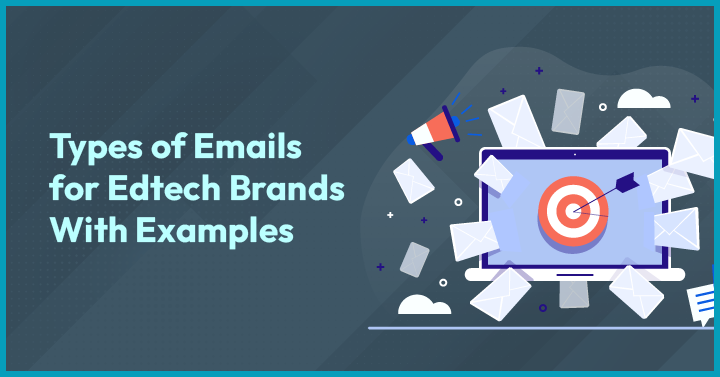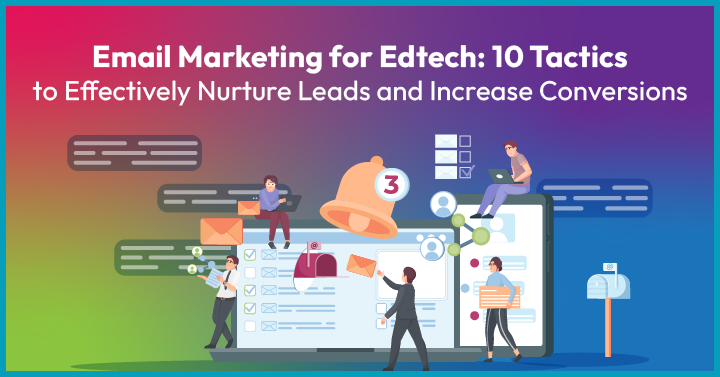HolonIQ’s report reveals a 16.3% CAGR growth in the EdTech sector, projecting that the global Education Technology market to reaching $404 billion by 2025.
This is a testimony to the fact that the edtech industry is evolving at a fast pace, bringing fresh opportunities for businesses. With hundreds of edtech firms entering the market, you need a unique strategy that showcases the usefulness of your products and services. Hence, it is crucial for Edtech companies to adopt effective marketing strategies to stand out in this competitive landscape.
One powerful tool that has proven to be highly effective is email marketing. Email marketing for edtech companies helps reach prospective clients, increase sales, and boost conversions. By leveraging the reach and personalisation capabilities of email, edtech brands can engage their target audience, communicate key messages, and establish a distinctive brand identity.
In this post, we’ll walk you through the best email marketing strategies for edtech to drive growth and boost revenue.
2. Why Should Edtech Companies Invest in Email Marketing?
Email marketing has emerged as a powerful marketing strategy for edtech companies. It offers a direct and personalised way to engage with potential customers, nurture leads, and drive conversions. Here are a few reasons why edtech companies should invest in email marketing:
- Communicate with the Target Audience
People appreciate good emails that keep them engaged throughout their journey. Email marketing for edtech enables you to reach more audiences and even communicate with them seamlessly. In addition, you can use personalised emails to educate your audience about your products/services while promoting your blog, social media, or landing pages.
- Drive Traffic to Your Website
Email marketing for edtech companies can drive quality traffic to your website and boost your targeted SEO efforts. By creating an email that links to your important content, social media pages, and website – you can get more and more traffic to your website. You can start with a healthy subscriber list and run promotional campaigns to increase website traffic. An effective email marketing strategy is essential for edtech brands to improve product/service exposure, boost enrolment, build strong relationships with prospects, increase customer retention, and elevate their brand.
- Generate Leads
Email marketing helps you qualify leads based on user activity on the email. For instance, if you implemented an email magnet (a free value offer that convinces users to give their email address) on your website – you can start drip emails and keep track of those who opened your emails or engaged by clicking on the links in your email. Email marketing for edtech can be used as an inbound marketing strategy to nurture leads and improve conversions.
- Run Cost-effective Campaigns
While paid media marketing campaigns like Google Ads and Facebook Advertising can be costly, email marketing for edtech tends to be cost-effective. You don’t have to pay when someone clicks on the mail or is redirected to your website. Instead, you can send a series of emails that help nurture the leads at different stages of their journey and convert them to potential customers.
- Delivers a High Return on Investment
According to Luisa Zhou, for every $1 spent on email marketing, the average ROI is $42. The high ROI of email marketing can be attributed to the targeted and personalised communication that it offers. It enables businesses to send personalised messages to specific groups helping them increase engagement and conversion rates. Additionally, email automation makes it easy to nurture leads and maintain customer relationships over time.
Re-engagement emails are sent to inactive subscribers with the purpose of re-engagement. They are typically designed to win back unsubscribed or unengaged subscribers to get them interested in your offer. Re-engagement emails are generally sent in sequence rather than as a single mail to win back unsubscribed users with some incentive.
- Webinar Invitations
Webinars are an effective way to educate your audience and showcase your expertise. Send out email invitations to your subscribers, providing details about the webinar topic, date, and time. Include a compelling CTA to encourage registrations. Example: “Join our upcoming webinar on ‘Revolutionising STEM Education’ and gain valuable insights from industry experts. Limited spots available, reserve yours today!”
- Course Recommendations
Based on the interests and preferences of your subscribers, recommend relevant courses that align with their goals and aspirations. Use personalised content and compelling visuals to highlight the benefits of each course. Example: “Discover your passion for coding! Enrol in our beginner-friendly coding course and unlock a world of opportunities in the tech industry.
6. How Can a Digital Marketing Agency Help?
A digital marketing agency specialising in Edtech can be a valuable expert in optimising your email marketing efforts. They have the expertise and industry knowledge to develop comprehensive marketing strategies tailored to the Edtech sector. From email campaign design, automation setup, list segmentation, and performance tracking, their experience and knowledge can help you drive better results.
Growth Ganik is a full-stack digital marketing agency specialising in all digital marketing services. Our experts can assist your Edtech company in developing a comprehensive email marketing strategy, creating compelling email content, and implementing automation tools. We also provide assistance in tracking and analysing email performance, identifying areas for improvement, and continuous optimisation of the email strategy for maximum impact.
Embrace the power of email marketing and take your Edtech business to new heights! Contact us today for a FREE 45-minute consultation with our experts and discover how we can help you leverage the power of email marketing to nurture leads and drive conversions.
7. FAQS
- What Is an Edtech Platform?
Edtech combines education and technology to improve student’s educational outcomes and in-classroom training.
- How Big Is the Edtech Industry?
The global edtech market is valued at $105.06 billion and is expected to reach $127 billion in 2022.
- How Do You Get Leads for Edtech?
To generate qualified leads in edtech, you should invest in SEO, social media, and email marketing for edtech. Additionally, you can conduct live webinars, enhance your landing pages, leverage Facebook ads, and guest blog for industry-related sites.
- How can I measure the success of my email marketing campaigns for Edtech?
To measure the success of your email marketing campaigns, track key metrics such as open rates, click-through rates, conversion rates, and unsubscribe rates. Analyse the data to identify trends, patterns, and areas for improvement. Additionally, set specific goals for each campaign and evaluate whether you have achieved them.
- How frequently should I send emails to my subscribers?
The frequency of your email campaigns depends on your target audience and the nature of your Edtech offerings. It’s important to find the right balance between staying top-of-mind and not overwhelming your subscribers. Test different frequencies and monitor the response rates to determine what works best for your audience.
- What are some best practices for email subject lines?
To optimise your email open rates, consider these best practices for subject lines:
– Keep them concise and to the point.
– Use action-oriented language to create a sense of urgency or excitement.
– Personalise the subject lines whenever possible.
– A/B test different subject lines to identify what resonates best with your audience.
- How can I prevent my emails from ending up in the spam folder?
To prevent your emails from being flagged as spam, follow these guidelines:
– Use a reputable email marketing service.
– Avoid using spam trigger words or excessive capitalization in your subject lines.
– Authenticate your domain and use SPF and DKIM records.
– Segment your email list and send targeted, relevant content to each segment.
– Include an unsubscribe link and honour unsubscribe requests promptly.
An effective email marketing strategy is essential for edtech brands to improve product/service exposure, boost enrolment, build strong relationships with prospects, increase customer retention, and elevate their brand.
4. Best practices for email marketing in the Edtech industry
While implementing the strategies mentioned above, it is essential to adhere to best practices for email marketing in the Edtech industry. Here are a few guidelines to follow:
- Compliance: Ensure that your email marketing practices comply with relevant regulations, such as the CAN-SPAM Act. Obtain proper consent from subscribers and provide clear options to unsubscribe.
- Consistency: Maintain a consistent brand voice and design across your emails. This helps build recognition and trust among your subscribers.
- Automation: Utilise email automation tools to streamline your campaigns and improve efficiency. Set up automated workflows for welcome emails, abandoned cart reminders, or course completion follow-ups.
- Personal Data Protection: Safeguard your subscribers’ personal data by implementing robust security measures. Encrypt sensitive information and regularly update your privacy policy to reflect your data protection practices.
5. Types of Emails for Edtech Companies, With Examples

- Welcome Series
The welcome series is a sequence of emails you send to people automatically after they sign up for your email. It is your business’s first interaction with your new subscribers after they have shown interest in your products or services. The main objective of these emails is to confirm a new registration and welcome them aboard. You can schedule a series of 3-5 emails to introduce your brand correctly.
- Newsletters
A newsletter is an email sent to your subscribers to keep them informed about the latest updates and news about your edtech brand. According to a survey, 40% of B2B marketers believe that newsletters play a crucial role in their content marketing success. Email newsletters help edtech firms achieve brand loyalty and customer retention. You can also address their questions about your brand in your email newsletters.
- Dedicated Emails
Dedicated email for edtech allows marketers to reach a specific audience. Also known as dedicated e-blast, this kind of advertising method is used by publishers to send messages on behalf of the advertiser. They contain multiple links to a landing page and direct calls to action.
- Lead Nurturing Emails
A lead nurturing email is a message sent to potential customers to push them towards the bottom of the funnel. It encourages them to engage, entice, and continue interacting with your business. It is a personalised and automated campaign that influences the user’s buying decision.
- Transactional Emails
A transactional email is sent in response to an action taken by the user on your website. Your website automatically sends it to the individual following a transaction or specific activity on the mobile app. They are typically sent to a particular user and are not used as a means to generate revenue. Examples of transactional emails include password reset, account creation emails, payment invoices, purchase receipts, order confirmation, payment failure, etc.
- Re-Engagement Emails
Re-engagement emails are sent to inactive subscribers with the purpose of re-engagement. They are typically designed to win back unsubscribed or unengaged subscribers to get them interested in your offer. Re-engagement emails are generally sent in sequence rather than as a single mail to win back unsubscribed users with some incentive.
- Webinar Invitations
Webinars are an effective way to educate your audience and showcase your expertise. Send out email invitations to your subscribers, providing details about the webinar topic, date, and time. Include a compelling CTA to encourage registrations. Example: “Join our upcoming webinar on ‘Revolutionising STEM Education’ and gain valuable insights from industry experts. Limited spots available, reserve yours today!”
- Course Recommendations
Based on the interests and preferences of your subscribers, recommend relevant courses that align with their goals and aspirations. Use personalised content and compelling visuals to highlight the benefits of each course. Example: “Discover your passion for coding! Enrol in our beginner-friendly coding course and unlock a world of opportunities in the tech industry.
6. How Can a Digital Marketing Agency Help?
A digital marketing agency specialising in Edtech can be a valuable expert in optimising your email marketing efforts. They have the expertise and industry knowledge to develop comprehensive marketing strategies tailored to the Edtech sector. From email campaign design, automation setup, list segmentation, and performance tracking, their experience and knowledge can help you drive better results.
Growth Ganik is a full-stack digital marketing agency specialising in all digital marketing services. Our experts can assist your Edtech company in developing a comprehensive email marketing strategy, creating compelling email content, and implementing automation tools. We also provide assistance in tracking and analysing email performance, identifying areas for improvement, and continuous optimisation of the email strategy for maximum impact.
Embrace the power of email marketing and take your Edtech business to new heights! Contact us today for a FREE 45-minute consultation with our experts and discover how we can help you leverage the power of email marketing to nurture leads and drive conversions.
7. FAQS
- What Is an Edtech Platform?
Edtech combines education and technology to improve student’s educational outcomes and in-classroom training.
- How Big Is the Edtech Industry?
The global edtech market is valued at $105.06 billion and is expected to reach $127 billion in 2022.
- How Do You Get Leads for Edtech?
To generate qualified leads in edtech, you should invest in SEO, social media, and email marketing for edtech. Additionally, you can conduct live webinars, enhance your landing pages, leverage Facebook ads, and guest blog for industry-related sites.
- How can I measure the success of my email marketing campaigns for Edtech?
To measure the success of your email marketing campaigns, track key metrics such as open rates, click-through rates, conversion rates, and unsubscribe rates. Analyse the data to identify trends, patterns, and areas for improvement. Additionally, set specific goals for each campaign and evaluate whether you have achieved them.
- How frequently should I send emails to my subscribers?
The frequency of your email campaigns depends on your target audience and the nature of your Edtech offerings. It’s important to find the right balance between staying top-of-mind and not overwhelming your subscribers. Test different frequencies and monitor the response rates to determine what works best for your audience.
- What are some best practices for email subject lines?
To optimise your email open rates, consider these best practices for subject lines:
– Keep them concise and to the point.
– Use action-oriented language to create a sense of urgency or excitement.
– Personalise the subject lines whenever possible.
– A/B test different subject lines to identify what resonates best with your audience.
- How can I prevent my emails from ending up in the spam folder?
To prevent your emails from being flagged as spam, follow these guidelines:
– Use a reputable email marketing service.
– Avoid using spam trigger words or excessive capitalization in your subject lines.
– Authenticate your domain and use SPF and DKIM records.
– Segment your email list and send targeted, relevant content to each segment.
– Include an unsubscribe link and honour unsubscribe requests promptly.
3. Email Marketing for Edtech: 10 Tips to Nurture Leads
With the increasing number of emails being sent and received every day, it’s important to stand out and offer value. Here are 10 tips to enhance your lead nurturing efforts and optimise your engagement with potential customers through email marketing:
3.1 Segment Your Target Audience
Edtech firms must be clear on their services/products and target audience. To implement a successful email marketing strategy, you must send the right emails to the right audience at the right time, and this is where segmentation can help. Knowing your audience will help you write with the perfect tone and convey your message.
Once you segment your target audience, you can then create individualised content that’s value-added and benefits them. The best educational email examples show how to nurture new leads and run an email campaign that engages your prospects throughout the buyer journey.
3.2 Write Catchy and Attractive Subject Lines
Writing catchy subject lines can be tricky, as they must be short and generate curiosity. Nearly 42% of people open emails based on the subject line. It means a clear subject line could make or break the campaign.
To capture the audience’s attention, your subject line should be within 60 characters. Make sure to use terms like – hurry up, important, opportunity, etc., to create a sense of urgency. Also, you must avoid words like “free” or “discount” to stay away from spam filters.
Based on the specific interests of your audience, you can introduce variations, including different subject lines, images, and messages, to increase engagement.
3.3 Personalise the Emails
There is no doubt that personalised marketing has impressive benefits for your edtech email campaign. With email marketing for edtech, you can create personalised content targeted to specific age groups. You can create unique content based on your audience’s preferences.
According to invesp, personalised emails have 29% higher open rates and 41% more click-through-rates. It also helps in boosting customer engagement. To personalise the emails, you can – Include the first name of the prospects, their demographics, gender, and interest.
It is a great way to familiarise your relationship with your customers. Make sure not to overuse the names – as it might damage your reputation. Make sure your emails have a clear purpose, and every word you put in the mail should be working towards the objectives.
3.4 Use Compelling Images and Videos
Use images and videos to convey your message more clearly. You can add videos of campus tours, brand stories, how-tos, guides, and student testimonials to spark an emotional connection. Besides, using images in emails helps boost engagement and is highly beneficial for driving conversions.
You should try to aim for the perfect text-to-image ratio by providing enough information. Do not overwhelm them with details or bore them to the point that they move your email from your inbox. Use bullet points, bold or italics for important information. Avoid using buttons or hyperlinks other than your CTA.
Here are some educational email examples of video email templates that can be downloaded and used right away in your edtech marketing campaign –
- Advanced Video template with Builder Application by Play
- Multi-Purpose Template by Mira
- Video Email Template from Wistia
- Video Email Templates from Stripo
3.5 Design Responsive Emails
According to sources, 70% of people read on their mobile devices, which means you should optimise your emails for mobile devices to increase open rates. You might consider different templates that have been customised as per the device. With responsive design, you can send emails that change their size depending on the screen on which they are viewed.
Responsive email templates use CSS media queries to produce multiple copies that depend on the user’s screen. For a better user experience, you should stick to a single-column layout to make it easier for your audience to read your content. It is advised to use 13 pt for the text and 20 pt for titles to make the content much more readable on smaller screens. Here are some responsive email templates for edtech –
- Promo email template “good choices” for the education industry
- Back-to-school email template “useful skills”
- Edutech – multipurpose education email template
- School email template – responsive
3.6 Include Multiple CTAs
A CTA in an email is a hyperlinked line of text or button that directs the user to your edtech website. You can include catchy CTAs with clear steps to direct the readers. Some of the best practices to include CTAs include using power/action words, adding buttons for the CTAs, and using contrast colours and borders.
Before designing or writing a CTA, you must know what you want the reader to do. For instance, if you are promoting an eBook download, you must send the reader to the landing page and download the eBook. For newsletters, blogs, or events, you can add the “Find Out More” or “Know More” button.
Whatever the purpose of your CTA, make sure the user knows they are taking action in response to the content they have just read. Use a service like an email on acid or Litmus to see how your email will appear in your audience’s inboxes.
3.7 Schedule Emails at the Best Times
When it comes to the success rate of the best edtech campaigns, timing is everything. You should choose the time wisely for improved click-through rates. According to Marketo, the best time of the day to send emails is 10 am. Also, emails should ideally be scheduled on Tuesday, Wednesday, and Thursday for higher open and click-through rates.
There is no one-size-fits solution to maximise the open rate. The best way is to test your emails at different times and weeks for better engagement. You can also check the recipient’s time zone and pre-schedule the emails based on their living location.
Specific tools, like Buffer, Hootsuite, Constant Contact, etc., help you determine the best time to shoot an email campaign.
3.8 Automate the Emails
Today, 51% of companies use marketing automation for the best edtech campaigns. There are countless marketing automation tools that can help edtech firms to execute multivariate testing to find the ideal email strategy.
With the help of these tools, you can intelligently decide which users engage most with your email based on their previous behaviour. You can set up different types of emails to automate based on behaviour-based triggers, demographic-based triggers, and time-based triggers.
Some of the best marketing automation tools for edtech are – WebEngage, NoPaperForms, and SocialChamps.
3.9 Repurpose on Social Media
To optimise the effect of your email marketing for edtech, you can share it on different social media platforms. You can cross-promote on these platforms by adding social media links or newsletter signups in your emails.
Facebook, LinkedIn, Instagram, and Twitter are the best channels for Edtech to promote your emails. Besides, you can also invest in social media ad campaigns for more reach and conversions. All you need to do is just share the email on your social media pages and give them a boost. With social media advertising for edtech, you can direct the prospects to the landing page and capture their email address.
You can also repurpose the content on your social media pages by rounding up the most popular posts and sharing them in an email.
3.10 Measure the Effectiveness of Campaigns
Make sure to track the results and performance of your email campaigns. Some key metrics to focus on are open rate, click-through rate, response rate, unsubscribe rate, and so on. Then, based on the performance of the campaigns, you can evaluate the subject line, image, send times, etc.
To measure the effectiveness of your email campaign, you should conduct A/B testing, which is the practice of sending two different emails under the same audience segment and understanding which one inspires your audience.
An effective email marketing strategy is essential for edtech brands to improve product/service exposure, boost enrolment, build strong relationships with prospects, increase customer retention, and elevate their brand.
4. Best practices for email marketing in the Edtech industry
While implementing the strategies mentioned above, it is essential to adhere to best practices for email marketing in the Edtech industry. Here are a few guidelines to follow:
- Compliance: Ensure that your email marketing practices comply with relevant regulations, such as the CAN-SPAM Act. Obtain proper consent from subscribers and provide clear options to unsubscribe.
- Consistency: Maintain a consistent brand voice and design across your emails. This helps build recognition and trust among your subscribers.
- Automation: Utilise email automation tools to streamline your campaigns and improve efficiency. Set up automated workflows for welcome emails, abandoned cart reminders, or course completion follow-ups.
- Personal Data Protection: Safeguard your subscribers’ personal data by implementing robust security measures. Encrypt sensitive information and regularly update your privacy policy to reflect your data protection practices.
5. Types of Emails for Edtech Companies, With Examples

- Welcome Series
The welcome series is a sequence of emails you send to people automatically after they sign up for your email. It is your business’s first interaction with your new subscribers after they have shown interest in your products or services. The main objective of these emails is to confirm a new registration and welcome them aboard. You can schedule a series of 3-5 emails to introduce your brand correctly.
- Newsletters
A newsletter is an email sent to your subscribers to keep them informed about the latest updates and news about your edtech brand. According to a survey, 40% of B2B marketers believe that newsletters play a crucial role in their content marketing success. Email newsletters help edtech firms achieve brand loyalty and customer retention. You can also address their questions about your brand in your email newsletters.
- Dedicated Emails
Dedicated email for edtech allows marketers to reach a specific audience. Also known as dedicated e-blast, this kind of advertising method is used by publishers to send messages on behalf of the advertiser. They contain multiple links to a landing page and direct calls to action.
- Lead Nurturing Emails
A lead nurturing email is a message sent to potential customers to push them towards the bottom of the funnel. It encourages them to engage, entice, and continue interacting with your business. It is a personalised and automated campaign that influences the user’s buying decision.
- Transactional Emails
A transactional email is sent in response to an action taken by the user on your website. Your website automatically sends it to the individual following a transaction or specific activity on the mobile app. They are typically sent to a particular user and are not used as a means to generate revenue. Examples of transactional emails include password reset, account creation emails, payment invoices, purchase receipts, order confirmation, payment failure, etc.
- Re-Engagement Emails
Re-engagement emails are sent to inactive subscribers with the purpose of re-engagement. They are typically designed to win back unsubscribed or unengaged subscribers to get them interested in your offer. Re-engagement emails are generally sent in sequence rather than as a single mail to win back unsubscribed users with some incentive.
- Webinar Invitations
Webinars are an effective way to educate your audience and showcase your expertise. Send out email invitations to your subscribers, providing details about the webinar topic, date, and time. Include a compelling CTA to encourage registrations. Example: “Join our upcoming webinar on ‘Revolutionising STEM Education’ and gain valuable insights from industry experts. Limited spots available, reserve yours today!”
- Course Recommendations
Based on the interests and preferences of your subscribers, recommend relevant courses that align with their goals and aspirations. Use personalised content and compelling visuals to highlight the benefits of each course. Example: “Discover your passion for coding! Enrol in our beginner-friendly coding course and unlock a world of opportunities in the tech industry.
6. How Can a Digital Marketing Agency Help?
A digital marketing agency specialising in Edtech can be a valuable expert in optimising your email marketing efforts. They have the expertise and industry knowledge to develop comprehensive marketing strategies tailored to the Edtech sector. From email campaign design, automation setup, list segmentation, and performance tracking, their experience and knowledge can help you drive better results.
Growth Ganik is a full-stack digital marketing agency specialising in all digital marketing services. Our experts can assist your Edtech company in developing a comprehensive email marketing strategy, creating compelling email content, and implementing automation tools. We also provide assistance in tracking and analysing email performance, identifying areas for improvement, and continuous optimisation of the email strategy for maximum impact.
Embrace the power of email marketing and take your Edtech business to new heights! Contact us today for a FREE 45-minute consultation with our experts and discover how we can help you leverage the power of email marketing to nurture leads and drive conversions.
7. FAQS
- What Is an Edtech Platform?
Edtech combines education and technology to improve student’s educational outcomes and in-classroom training.
- How Big Is the Edtech Industry?
The global edtech market is valued at $105.06 billion and is expected to reach $127 billion in 2022.
- How Do You Get Leads for Edtech?
To generate qualified leads in edtech, you should invest in SEO, social media, and email marketing for edtech. Additionally, you can conduct live webinars, enhance your landing pages, leverage Facebook ads, and guest blog for industry-related sites.
- How can I measure the success of my email marketing campaigns for Edtech?
To measure the success of your email marketing campaigns, track key metrics such as open rates, click-through rates, conversion rates, and unsubscribe rates. Analyse the data to identify trends, patterns, and areas for improvement. Additionally, set specific goals for each campaign and evaluate whether you have achieved them.
- How frequently should I send emails to my subscribers?
The frequency of your email campaigns depends on your target audience and the nature of your Edtech offerings. It’s important to find the right balance between staying top-of-mind and not overwhelming your subscribers. Test different frequencies and monitor the response rates to determine what works best for your audience.
- What are some best practices for email subject lines?
To optimise your email open rates, consider these best practices for subject lines:
– Keep them concise and to the point.
– Use action-oriented language to create a sense of urgency or excitement.
– Personalise the subject lines whenever possible.
– A/B test different subject lines to identify what resonates best with your audience.
- How can I prevent my emails from ending up in the spam folder?
To prevent your emails from being flagged as spam, follow these guidelines:
– Use a reputable email marketing service.
– Avoid using spam trigger words or excessive capitalization in your subject lines.
– Authenticate your domain and use SPF and DKIM records.
– Segment your email list and send targeted, relevant content to each segment.
– Include an unsubscribe link and honour unsubscribe requests promptly.

















